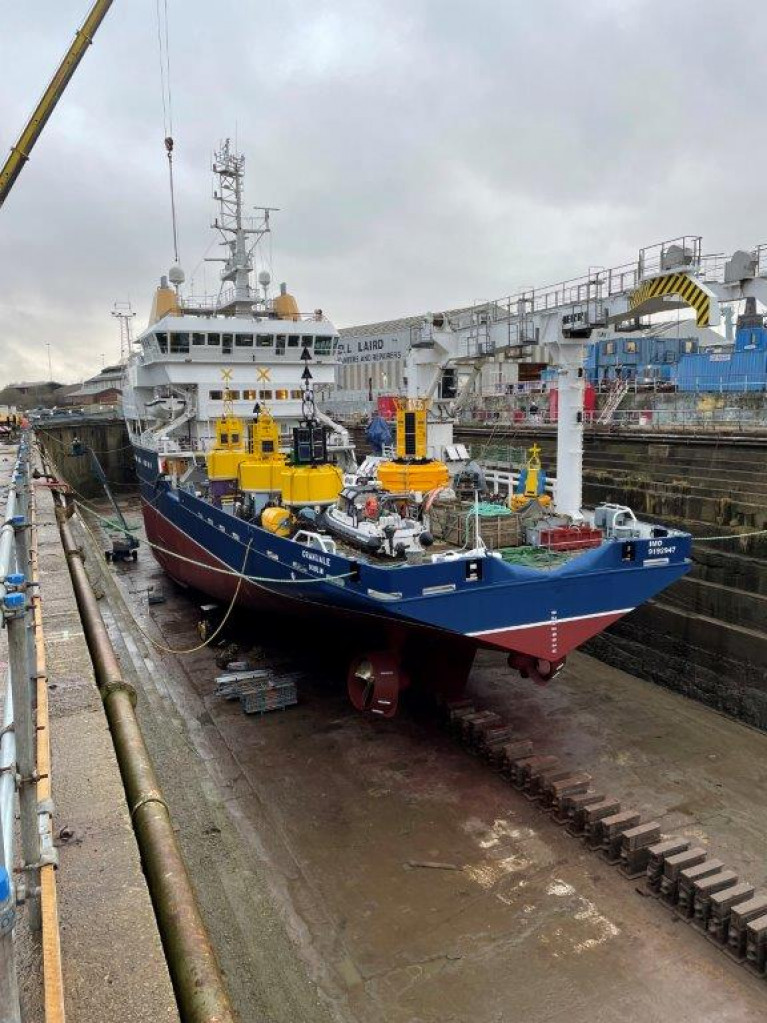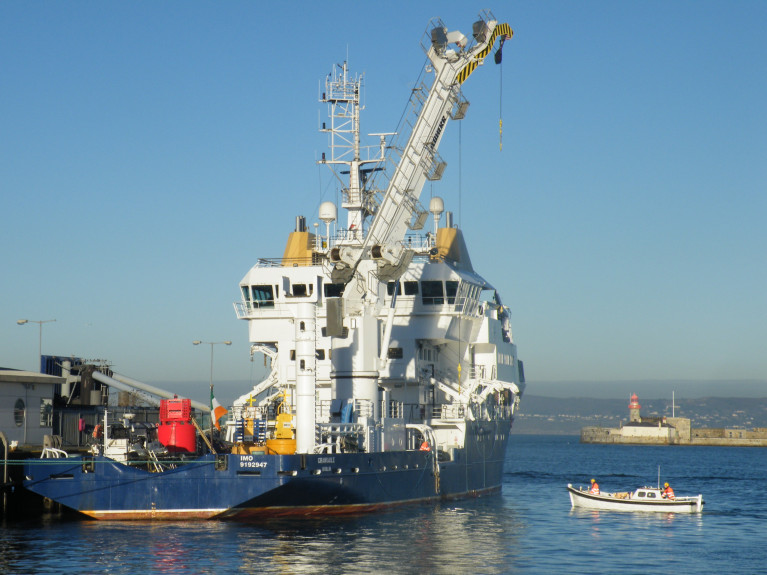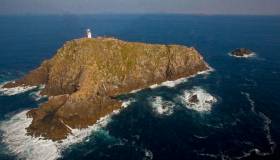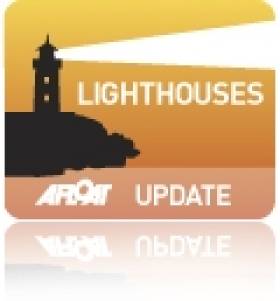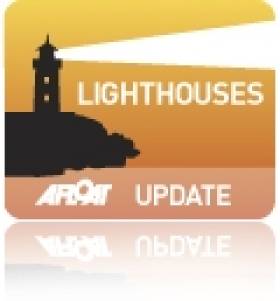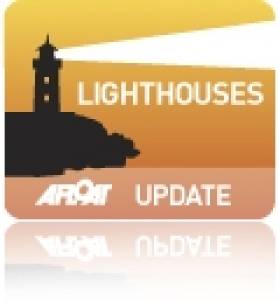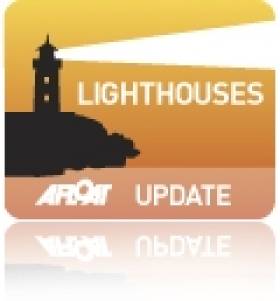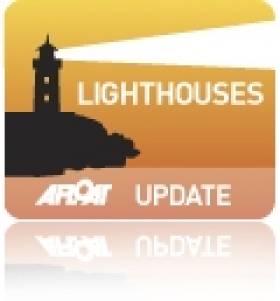Displaying items by tag: ILV Granuaile
Irish Lights is recruiting for an Operations Officer and Deck Supervisors on board our multi-purpose DP 1 vessel, Granuaile. The ship’s crews work a time on time off roster. There are two Deck Supervisors positions, one for each duty period.
These exciting, challenging and rewarding roles will give the successful candidates an opportunity to join a team that help maintain Aids to Navigation around the coast of Ireland. An attractive time on time off roster and generous defined benefit pension scheme is available.
THE SHIP
Granuaile is an Irish Flagged 80 meter multi-purpose DP1 vessel with a 20 tonne crane and significant mooring handling capabilities. She is a diesel electric ship powered by 5 x MAN gensets with total power of 3700kW driving 2 x Schottel Azi Pod propellers and a Gill Jet Azitumth Bow Thruster. She is classed by Lloyds and has UMS notation. Primary duties involve maintenance of floating and fixed Aids to Navigation. Over the ships 20 years in operation she has successfully completed a wide range of offshore contracts including subsea operations.
OPERATIONS OFFICER ROLE
As Operations Officer you will keep navigational watches and provide support to the Master and Senior Operations Officer in all aspects of the ships administration and operational tasking. As well as undertaking these duties, you will be involved in maintaining Aids to Navigation including Lighthouses, and Buoys and surveying the Irish Coast utilising the latest surveying technology.
DECK SUPERVISOR ROLE
As Deck Supervisor you will be involved in a variety of shipboard duties as directed by the Senior Operations Officer (Chief Officer). You will be responsible for the supervision of crew in day to day deck maintenance and supervision of deck operations including buoy mooring and maintenance and the supervision of the maintenance of aids to navigation, including offshore stations and buoys and support for charter operations.
FURTHER DETAILS ON THE REQUIREMENTS
Please visit our website (www.irishlights.ie/who-we-are/vacancies) to view the Candidate Briefing Packs which give further information on the specific role and its requirements.
Please apply, specifying which role you are applying for, by emailing a CV and cover letter to Gemma Gregan at [email protected].
Please view Irish Lights Job Applicant Privacy Notice on our website.
Irish Lights is recruiting for a Senior Operations Officer (SOO) to fill a challenging and rewarding role on board their multi-purpose DP 1 vessel, Granuaile.
THE SHIP
ILV Granuaile is a multifunctional vessel that primarily operates in the waters around the coast of the Island of Ireland. Its primary function is to place and service offshore buoys, which warn mariners of the location of sand banks, reefs and other offshore hazards near shipping routes. The vessel also serves as a helicopter platform for servicing offshore lighthouses and is available to assist State agencies with search and rescue, emergency towing, oil pollution control, surveying and offshore data collection.
THE ROLE
The SOO supports the Master in all elements of Ship Administration, Safety Management and Service Operations. The role is responsible for managing the crew and junior deck officers and holds a navigation watch when necessary. The SOO plays a major role in the practical supervision of all deck maintenance and service operations including replenishment of stations and maintenance of buoys and moorings and has an important role in charter operations.
THE REQUIREMENTS
Candidates must have offshore experience and hold a valid STCW Unlimited Masters Certificate and full valid DP certification. Excellent seamanship and navigation skills are necessary, together with a working knowledge of statute and regulations. The ability to communicate at all levels and excellent communication skills are also essential.
An attractive salary, time on time off roster and pension scheme is available. Please click here to view the Candidate Briefing Pack for further information on the role and requirements. Please note that Irish Lights only pay for travel expenses incurred within the island of Ireland.
The closing date for applications is the close of business on Tuesday, 31 May 2022. Please apply by emailing a CV and cover letter to Gemma Gregan at [email protected].
Please view Irish Lights Job Applicant Privacy Notice on our website.
As previously reported on Afloat, Cammell Laird, the Merseyside shipbuilder and engineering facility has been kept busy with dry-docking a range of ships among them the Commissioners of Irish Lights vessel ILV Granuaile, writes Jehan Ashmore.
The aids to navigation vessel built in 2000, mainly serves in the deployment and recovery of buoys, both inshore & offshore and is used for search and rescue missions, underwent dry-docking at the Birkenhead based facility.
Commenting to Afloat on the dry-docking, Irish Lights said, following a competitive tender process to ensure value for money, ILV Granuaile completed an Intermediate drydock in Cammell Laird during January.
As per SOLAS and Flag State requirements, all merchant vessels require a complete survey of the hull (Special drydock) every five years and an Intermediate survey mid-way in the intervening period. These dry-dockings, include maintenance of the hull, thrusters, anodes, cooling inlets and other parts which are immersed in water and normally inaccessible.
All planned work was delivered and the ship has now returned to regular duties of maintaining lighthouses, buoys and beacons around the coast of Ireland.
Afloat adds ILV Granuaile is currently working in waters off northern Donegal having departed Dun Laoghaire Harbour in recent days.
Irish Lights Look to Future Replacement of Aids to Navigation Vessel ILV Granuaile
The Commissioners of Irish Lights, the General Lighthouse Authority (GLA) responsible for aids to navigation in waters off Ireland, operates the buoy-laying vessel ILV Granuaile which this year entered its 23rd year in service, writes Jehan Ashmore.
For more than two decades ILV Granuaile has served in its primary function to place and service the 150 offshore buoys of Ireland's long and rugged coastline notablyalong the western seaboard. The bouys warn mariners of the location of sand banks, reefs and other offshore hazards near shipping routes, essential to an island nation given our economic trade is highly dependent on maritime routes connecting Europe and beyond.
ILV Granuaile began service in January 2000, a newbuild that was then one of the most advanced vessels of its type in the world. The newbuild's design, saw buoy operations radically shifted away from the traditional located forward work deck area near the bow to that of the aft-deck.
When ILV Granuaile made its debut in the first month of the millenium, this marked a notable prototype for Irish Lights and would lead to GLA counterparts in England, Wales, Channel Island & Gibraltar (Trinity House) and for Scotland & the Isle of Man (Northern Lighthouse Board) to follow suit with similar vessels. This led to the commissioning of THV Galatea and NLV Pharos respectively.
In addition, ILV Granuaile also formed a prototype for Relume, that initially served the Middle East Navigation Aids Service (MENAS) and in which during last summer, the vessel carried out survey work off the Irish east coast for a windfarm project.
Plans are in place to replace two buoy-laying vessels in the coming years, as Afloat previously reported, Trinity House's ageing THV Patricia (built 1982) and the Northern Lighthouse Board's NLV Pole Star (built 2000). In the same year ILV Granuaile was delivered to Irish Lights, having been built in a Romanian shipyard and with outfitting carried out in the Netherlands.
Irish Lights Statement on replacing ILV Granuaile
Afloat contacted Irish Lights in regards to the operational life-span of the aids to navigation vessel with CIL responding below on the possible future replacement of the vessel.
The Commissioners of Irish Lights is a maritime organisation delivering an essential safety service around the coast of Ireland, protecting the marine environment, and supporting the marine industry and coastal communities. We provide maritime aids to navigation services to meet the State’s legal obligation under SOLAS Chapter V, Regulation 13 and we enhance safety of navigation for all seafarers, including the merchant fleet, the fishing sector and the leisure sector.
In delivering our services we rely substantially on the capability of our buoy tender vessel, the ILV Granuaile; the third Irish Lights vessel to bear the name Granuaile. Built in 2000, the current Granuaile is extremely maneuverable as a Class 1 DP vessel and capable of a wide variety of mission profiles including maintenance of aids to navigation, wreck response and reacting to new dangers to navigation, Search and Rescue/Recovery and response to oil pollution. (See related pollution recovery exercise, as featured in 'Maritime Dalkey' DCC Newsletter, Feb.2015 p. 11 and 13).
Irish Lights operates in close cooperation and mutual support with our sister GLA, Trinity House and the Northern Lighthouse Board. In total, the three GLAs operate seven vessels, of which two vessels THV Patricia and NLV Pole Star (have both Afloat adds shared duties in Irish waters) are approaching end-of-service life and will be replaced in the coming years.
ILV Granuaile has benefitted from all required upgrades and maintenance during her service life, including new bridge navigation and control equipment suite, enhanced sonar capability and upgrades to all critical systems onboard. This has allowed the ship to exceed the requirements for certification by Lloyds and the Flag State. Therefore, it is expected that the ship will continue to operate successfully well into the latter part of this decade.
However, like all vessels she will eventually require replacement and Irish Lights has included this requirement in our strategic planning considerations for the period out to 2030.
It is expected that Irish Lights will benefit greatly from the lessons learned by our sister organisations in Scotland and England in terms of fuel choice and energy efficiency of any new vessel design.
For the moment, we will continue to successfully operate the ILV Granuaile providing maritime services to the State and our user groups, while we begin to work on planning for her eventual replacement in the medium to long term.
Charter Role
The versatile design of ILV Granuaile also makes her ideal for commercial hire, which allows Irish Lights to use any reserve capacity of the vessel to reduce the cost of provision of aids to navigation to the State.
#Rescue116 - The Irish Lights vessel Granuaile is in Galway preparing to join the search for the missing crew of Rescue 116, according to Galway Bay FM.
The multifunctional vessel, built to operate in difficult sea conditions, is being stocked with additional equipment ahead of a major search of the crash site off Blacksod in Co Mayo scheduled for tomorrow (Sunday 19 March) with the forecast of improved weather conditions.
TheJournal.ie reports that what’s believed to be wreckage from the Sikorsky S92 helicopter has been found on the island of Black Rock, west of Blacksod, but there are no signs of a crash having occurred at that site.
The coastguard helicopter’s black box was also detected on Wednesday (15 March) near the island, but divers have been prevented from reaching its location due to the poor weather and sea state.
Three crew – chief pilot Mark Duffy and winch men Paul Ormsby and Ciarán Smith — remain missing after the incident in the early hours of Tuesday (14 March) as the Dublin-based Irish Coast Guard helicopter provided top cover for a medevac.
The funeral of Capt Dara Fitzpatrick, who was taken from the scene in the first hours of the search and rescue effort, takes place this morning (Saturday 18 March).
Meanwhile, it emerged on Thursday (16 March) that Rescue 116 was tasked to the scene on Tuesday after the Irish Air Corps was unable to provide assistance due to reduced capacity, according to The Irish Times.
Irish Lights Tender Departs Cork Following Dry Docking Sea-Trials
#DryDocking - ILV Granuaile (2000/2,625grt) departed Cork Harbour and is bound for Rosslare Harbour this evening having undergone dry-docking, writes Jehan Ashmore.
Among the work carried out on the Commissioners of Irish Lights tender at Cork Dockyard were some service work done on thrusters and re-chroming of crane rams.
The Dutch Damen Group which built the vessel at their Romanian yard in Galati, had also undergone in Cork Dockyard last year a major '15 Special Survey & Dry-Docking'. The Rushbrooke yard fought off stiff competition for the EU tender as part of a €650,000 project to enable continued operation to Lloyds +100A1 Classification.
ILV Granuaile yesterday morning departed a river-berth for sea-trials. This involved the 79m long lighthouse tender pass Cobh to where a pair of UK registered factory trawlers berthed following detention off the Blaskets by the Naval Service.
She then headed beyond Roches Point Lighthouse, marking the entrance to Cork Harbour from where a circuit was made at sea before returning to the dockyard.
The trawlers Wiron 5 and Wiron 6 are 55m in length and have a Dutch crew of 14 each. They were detained for alleged fishery infringements by the OPV L.E. Samuel Beckett (P61) which escorted the vessels to Cobh and then she headed upriver to berth in Cork City quays.
#UKMetOfficeBuoy – The Commissioners of Irish Lights tender ILV Granuaile (2000/2,625grt) successfully deployed a KI buoy recently for the UK's Met Office.
The positioning of the deep-water mooring buoy took place some 250 miles west of the French port of Brest in Brittany.
The Romanian built / Dutch outfitted Granuaile, has previously carried out maintenance visits on the K1 buoy, this was the first time a completely new set of moorings was deployed.
The extreme length of the cable introduced new and potentially hazardous challenges to the ships personnel.
In total almost 2,500 meters of a mixture of rope and chain moorings were deployed in depths of 1,500 m.
The successful deployment of the deep-water mooring proved how versatile and innovative the Granuaile is and that of her crew when faced with tough new offshore challenges.
Lighthouse Tender Carries Out Trial Runs Since Modifications
#LighthouseTender- ILV Granuaile the aids to navigation tender is carrying out another trial run of systems at sea today in Dublin Bay and off Greystones, writes Jehan Ashmore.
As previously reported on Afloat.ie, the Commissioners of Irish Lights 79m tender had undergone work that has involved the installation of a new radar mast, calorifier units and modifications to the bridge.
Arklow Marine Services carried out the work while the vessel was berthed in the port along Sir John Rogersons Quay.
The 2,625 tonnes buoy-handling vessel is expected to return to her homeport of Dun Laoghaire Harbour tonight.
Modification Work for Irish Lights Aids to Navigation Vessel
#LighthouseTender – The Commissioners of Irish Lights ILV Granuaile (2000/2,625grt) an aids to navigation tender vessel, is undergoing steel modification works while berthed in Dublin Port, writes Jehan Ashmore.
Work on the 79m long tender which is moored at Sir John Rogersons' Quay close to the East-Link Bridge, is been carried out by Arklow Marine Services.
The work involves fabricating of a new radar mast, installation of calorifier units and modifications to the bridge.
Steel work modifications entail fitting under deck strengthening in way of ROV pads which are to be in accordance and to the approval of Lloyds.
Killybeg based Barry Electronics are supplying and fitting a new radar which requires a new mast with existing steelwork and platform being removed.
The new calorifier unit which is to replace existing plant will be piped in using 316 stainless steel pipe materials. It is expected the quayside work be completed by the middle of this month.
ILV Granuaile is the third tender to carry the name of the famous Mayo pirate Queen.
She was built by the Damen Shipyards Group, where the hull and superstructure were completed in Romania in Galati, the largest port town on the River Danube.
Following launching, she was towed through the Black Sea to the Netherlands for fitting out at another Damen shipyard, where work included the installation of electronic equipment.
Cork Dockyard Carries Out Docking Survey of Lighthouse Tender
#DOCKING SURVEY– The Commissioners of Irish Lights aids to navigation tender ILV Granuaile (2000/2,625grt) is currently at Cork Dockyard Ltd undergoing her scheduled docking survey, writes Jehan Ashmore.
The tender built in Romania over a decade ago and fitted out in the Netherlands by the Damen Shipyard Group, is required under regulation to drydock twice in five-yearly cycles. Her last docking was in 2009 and the the bouy-laying vessel is due her next scheduled docking in 2014.
Such docking is required by Classification Societies to inspect the underwater areas including hull, propellers, rudders, engine cooling systems, anchors, cables and anti corrosion systems.
At the same time the opportunity is taken to remove marine growth and to apply antifouling paint coatings to the underwater areas and to prepare and paint the ships hull. The principle dimensions of the hull are 79m long on a beam of 15m and with a shallow draft of 4.4m.
She has accommodation for an extra 10 persons or can accept modular housing on the after-deck where navigational aids (bouys) are stowed in cradles. Heavy lifting equipment including a 20 tonne crane with an outreach of 20m is used to position the bouys at pinpoint accuracy using satellite technology. There are 150 offshore buoys which warn mariners of the location of sand banks, reefs, and other offshore hazards near shipping routes.
A helicopter landing deck over the bow is used to transfer maintenance personnel and equipment to certain lighthouses.
ILV Granuaile's homeport is Dun Loaghaire Harbour, where she is seen frequently loading and unloading buoys alongside the various piers. On occasions she enters through the marina to berth alongside the Commissioners headquarters which includes a marine workshop depot facility, though this can only be done on certain tides and for a short duration.
Asides her primary duties serving the lighthouse authority, the vessel is capable of carrying out chain work, search and rescue, salvage and recovery, oil pollution control, towing, hydrographic applications, and ROV work.



























